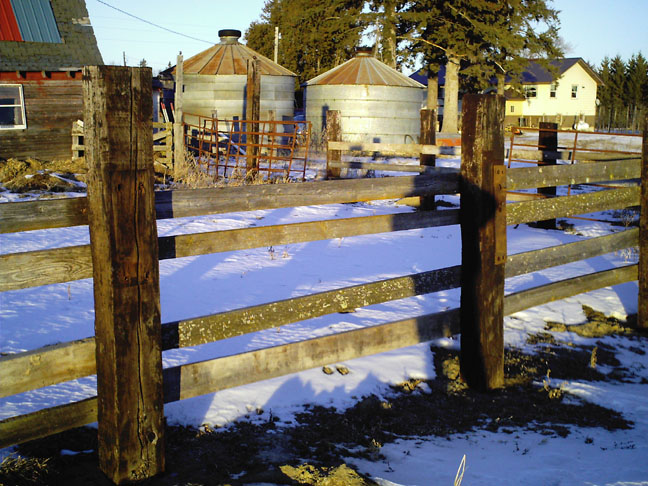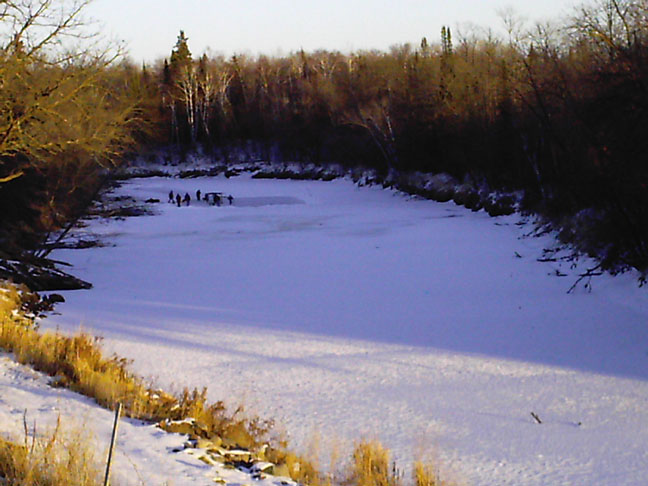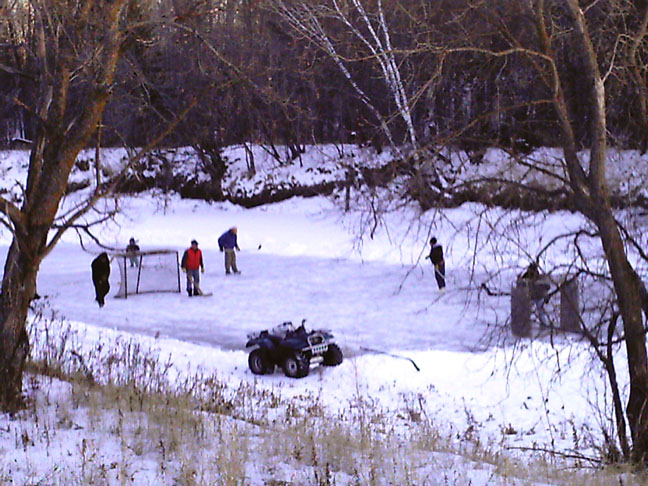Pragmatic Art: The Salvaged Resource
Aaron Lundstrom describes fencebuilding and pond hockey as sculpture--he's looking at broadening notions of creativity.



Aaron Lundstrom moved to Baudette, a small town on the Canadian border, earlier this year. He was interested in the potential of rural culture to produce something like Joseph Beuys’s “social sculpture”—creativity reinventing daily life. He’s been swapping knowledge with the locals, who’ve given him lessons in the continual necessity of creative making among farmers and others to whom “amenities” is a strange word. Here’s a report from the front.
The beauty of the world’s resources comes not only from their contribution to sustaining life, but also from the lessons that are learned by working with them. Artists can learn a lot from the materials they use and how these materials are exchanged throughout the world. But how much appreciation is there for the human resource? Are we fresh water to be preserved, or are we crude oil to be consumed?
Connections seen between the physical environment of the natural world and the man-made environment of society are made clearer by looking at the management of our valuable materials. For instance, how we view food and water has a connection to how we view people. We can bluntly use these resources for our own purpose and then forget about giving anything back, or we can cooperate with these resources and work a living art.
I was recently given the opportunity to do some real work on a real working farm in Clementson, Minnesota, which is about 60 miles west of International Falls. The farm belongs to David and Louise Erickson and their fence needed repairing. I had helped build a fence once in the past and yet I felt just as clueless this time as I did before. I was in the territory of the farmer, and the farmer always seems to know more than I do.
David and Louise strive to live simply. They raise cattle and pigs and they maintain strong relationships with their grown children and grandchildren (some of whom build sculptures with scrap metal and used motor parts). They grow a garden, they log, they hunt, they can food, they fish, and they give. They give a lot.
I was helping repair this fence with another worker, a friend of mine. David would ordinarily do this work himself but he wasn’t feeling well, presenting this unique opportunity. David and Louise have the reputation of being very generous—a reputation which I had experienced firsthand—and so I was looking forward to giving something back to them.
So that day we learned about the art of the salvaged fence. For fence posts we used the old railway ties that are thrown to the side of the tracks after new ties are installed by the rail company. In the process of fencing we were twice called into the house by Louise to warm up and eat. We were fed well. We were warmed. After we finished working I was ready to go home satisfied—satisfied with the experience; satisfied that I helped out by giving my time and effort to give back to those who deserved; and satisfied, also, with warm food in my stomach.
But David and Louise weren’t finished working. They presented an additional gift by showing the art of giving beyond what you’ve received. Louise put out some canned meat and some onions for us to take home. Then David took out his checkbook insisting that he was going to pay us for a few hours of work and for obtaining a decent portion of their food. We talked him down, but only a little. “How much is your freezer?” David asked my friend. It was hunting season and my friend needed to buy a freezer for storing venison. David wrote out a check for the amount.
After an experience like this one it’s unsettling to hear about the global disrespect for life’s resources, both physical and human. Every five seconds a child dies from hunger. Over a billion people have no access to clean water. Almost one in four mammal species is in serious decline, mainly due to human activities. And then there’s war. And then there’s waste. It’s no uncertainty why there is a steady search for beauty through art.
Repairing a fence with salvaged wood is admittedly not the type of art that draws crowds. But neither is it an intellectual parody of life. When you look at it you see its immediate purpose. You see its practicality and the life that it protects. Behind that fence you may see livestock. Outside of it you’ll see the organized effort of people inspiring others with their generosity and their deep survival in living.
I’ve been invited to the Erickson’s farm many other times, along with many other people. The invitation is not to work, but to play. David and Louise live along the banks of the Rapid River. In the winter, with the water frozen, they allow an area of snow to be cleared away, making a natural ice rink. People bring their ice skates for a small game of hockey and an afternoon near a fire. In the evening there is food and association with others who are there because they brought something to give, and because they know they will have something meaningful to take away.
Living in a world tainted with imbalance and conflict, beauty is a welcome comfort. As expressions of art vary and adapt to the world surrounding us, will beauty become increasingly difficult to find? Will we use our resources to the point where there is nothing left but evidence of abuse and missing appreciation? It seems as long as there are people working with the right materials, with the right motives and for the right cause, repair is always possible. In such circumstances a repaired fence links us to a repaired humanity, and a frozen river bears the weight. This is the pragmatic art of giving.